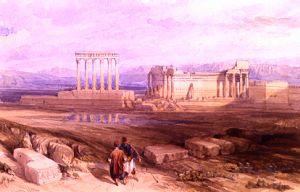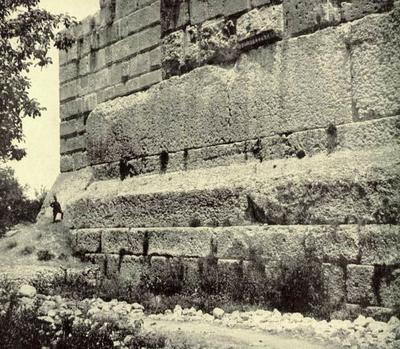BaalBek - Ancient Temple of Mystery
In the remote Bekaa Valley of Lebanon stand the ruins of what was once the most important temple in the Roman Empire. Here stood the Temple of Jupiter, and the great oracle upon whose words decisions of the Empire were made.

Baalbek, a painting by David Roberts, 1839.
Baalbek lies at the ancient crossroads of Palestine in the south, Damascus in the east, the sea in the west and Hamath in Upper Syria to the north-east. There is the possibility that it is the Biblical city of Dan, center of worship of the Northern tribes of Israel and a thriving center 800 years before Christ.
To the Romans it was Heliopolis, sharing the name with the important center of Sun worship in Egypt. The known, existing ruins - the massive Temple of Jupiter, the Temple of Bacchus, and the small Temple of Venus, are believed to be from Roman times by historians and, although the site is known to have been occupied as long ago as 2900 BC, the story ends there in the conventional mind.
A number of factors argue for an earlier date. There are no substantial records of the construction of Baalbek, a surprising omission for the Roman bureaucracy. The Giant Stones of the Jupiter Temple do not look like Roman stonework and are much larger than those used elsewhere. Baal is not a Roman god - it is the golden calf of the Bible - the Apis cult that should have died out at the end of the age of Taurus, somewhere around 2200 BC.
Then there is the famous oracle, as valued to the Romans as that at Delphi. Oracles are not created by Emperors. One must go to the place chosen by the gods.
And why would the Romans build a temple of Jupiter - god of thunder - in a place called Heliopolis? The Roman Emperor Aelius Antoninus Pius (138-161 AD) did extensive renovation at the site. A footnote to Immanuel Velikovsky's article on Baalbek may point to the answer: "... 65. Robinson suggested that Antonine rebuilt the great temple of the Sun and erected the lesser temple to Jupiter Baal (Biblical Researches, III, p. 520, n.6)."
Is the greatest temple of Baalbek still to be discovered?
 This old photograph shows a portion of the back wall of the Temple of Jupiter at Baalbek. There is a prominent indentation on the lower of the two rows of large stones. A man is standing by the left most stone of this row to show the scale of the picture. The lower of the two large rows is composed of stones 14 X 10 X 33 feet weighing about 300 tons (130,000 kg). This row or course circles the temple area and forms a solid platform with the floor. The course above it - the large stone shown, and two others, one of which is shown partly, form the Trilithon - the largest building stones ever used in construction anywhere in the world. Each stone is 14 X 12 X 64 feet and weighs an estimated 800 tons (700,000 kg). It is these stones that so encourage those who believe that there were earlier high civilizations in the Mediterranean that are now lost to history.
This old photograph shows a portion of the back wall of the Temple of Jupiter at Baalbek. There is a prominent indentation on the lower of the two rows of large stones. A man is standing by the left most stone of this row to show the scale of the picture. The lower of the two large rows is composed of stones 14 X 10 X 33 feet weighing about 300 tons (130,000 kg). This row or course circles the temple area and forms a solid platform with the floor. The course above it - the large stone shown, and two others, one of which is shown partly, form the Trilithon - the largest building stones ever used in construction anywhere in the world. Each stone is 14 X 12 X 64 feet and weighs an estimated 800 tons (700,000 kg). It is these stones that so encourage those who believe that there were earlier high civilizations in the Mediterranean that are now lost to history.
For a more in depth discussion of the stones of Baalbek see the AncientMystery.infoBaalBek Page
Hints and glimpses of an ancient mystery - the lost history of the Human Race, before the meager 6,000 years from which we have written texts:AncientMystery.info
For a look at Egypt from a different perspective than that promoted by mainstream archeology: AscendingPassage.com

Baalbek lies at the ancient crossroads of Palestine in the south, Damascus in the east, the sea in the west and Hamath in Upper Syria to the north-east. There is the possibility that it is the Biblical city of Dan, center of worship of the Northern tribes of Israel and a thriving center 800 years before Christ.
To the Romans it was Heliopolis, sharing the name with the important center of Sun worship in Egypt. The known, existing ruins - the massive Temple of Jupiter, the Temple of Bacchus, and the small Temple of Venus, are believed to be from Roman times by historians and, although the site is known to have been occupied as long ago as 2900 BC, the story ends there in the conventional mind.
A number of factors argue for an earlier date. There are no substantial records of the construction of Baalbek, a surprising omission for the Roman bureaucracy. The Giant Stones of the Jupiter Temple do not look like Roman stonework and are much larger than those used elsewhere. Baal is not a Roman god - it is the golden calf of the Bible - the Apis cult that should have died out at the end of the age of Taurus, somewhere around 2200 BC.
Then there is the famous oracle, as valued to the Romans as that at Delphi. Oracles are not created by Emperors. One must go to the place chosen by the gods.
And why would the Romans build a temple of Jupiter - god of thunder - in a place called Heliopolis? The Roman Emperor Aelius Antoninus Pius (138-161 AD) did extensive renovation at the site. A footnote to Immanuel Velikovsky's article on Baalbek may point to the answer: "... 65. Robinson suggested that Antonine rebuilt the great temple of the Sun and erected the lesser temple to Jupiter Baal (Biblical Researches, III, p. 520, n.6)."
Is the greatest temple of Baalbek still to be discovered?
 This old photograph shows a portion of the back wall of the Temple of Jupiter at Baalbek. There is a prominent indentation on the lower of the two rows of large stones. A man is standing by the left most stone of this row to show the scale of the picture. The lower of the two large rows is composed of stones 14 X 10 X 33 feet weighing about 300 tons (130,000 kg). This row or course circles the temple area and forms a solid platform with the floor. The course above it - the large stone shown, and two others, one of which is shown partly, form the Trilithon - the largest building stones ever used in construction anywhere in the world. Each stone is 14 X 12 X 64 feet and weighs an estimated 800 tons (700,000 kg). It is these stones that so encourage those who believe that there were earlier high civilizations in the Mediterranean that are now lost to history.
This old photograph shows a portion of the back wall of the Temple of Jupiter at Baalbek. There is a prominent indentation on the lower of the two rows of large stones. A man is standing by the left most stone of this row to show the scale of the picture. The lower of the two large rows is composed of stones 14 X 10 X 33 feet weighing about 300 tons (130,000 kg). This row or course circles the temple area and forms a solid platform with the floor. The course above it - the large stone shown, and two others, one of which is shown partly, form the Trilithon - the largest building stones ever used in construction anywhere in the world. Each stone is 14 X 12 X 64 feet and weighs an estimated 800 tons (700,000 kg). It is these stones that so encourage those who believe that there were earlier high civilizations in the Mediterranean that are now lost to history.For a more in depth discussion of the stones of Baalbek see the AncientMystery.info
Hints and glimpses of an ancient mystery - the lost history of the Human Race, before the meager 6,000 years from which we have written texts:
For a look at Egypt from a different perspective than that promoted by mainstream archeology:
Labels: Ancient Mysteries, Archaeology, Baalbek Lebanon

0 Comments:
Post a Comment
<< Home